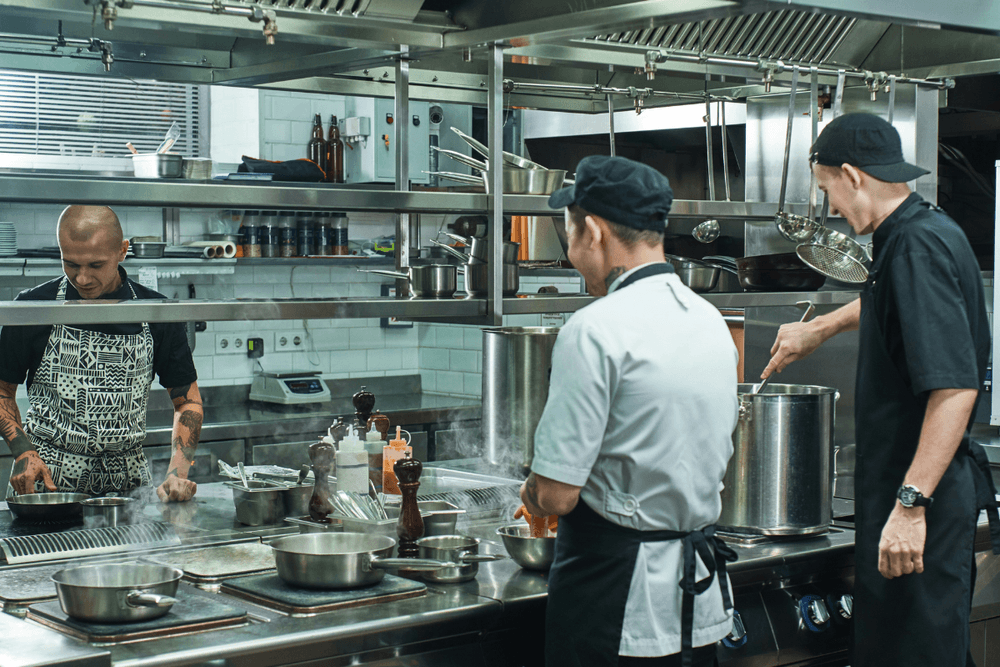Finding the right commercial kitchen space: A guide for growing catering businesses
Table of Contents
CloudKitchens
How many tacos can be delivered from a 1000sqft restaurant?
The same amount as a 200sqft ghost kitchen.
Finding the right commercial kitchen space for your catering business is about much more than square footage or equipment, it’s about creating an environment tailored for successful, scalable operations.
Whether you’re launching a new business or preparing to expand, the process requires a careful balance of workflow efficiency, menu complexity, storage needs, future growth, and budget.
This in-depth guide takes a practical approach to help you navigate the commercial kitchen space landscape. Drawing on industry benchmarks, proven design principles, and planning best practices, you’ll gain actionable insights to avoid costly mistakes and set your business up for long-term, scalable success.
Understanding commercial kitchen space requirements
Finding the right commercial kitchen space isn’t just about having enough space, it’s about shaping your production environment for productivity and safety.
Too small, and you’ll face bottlenecks, compromised food and health safety, and staff stress. Too large, and you risk wasted space, higher rent, and inefficient workflows. The goal is to strike the right balance based on your current and anticipated production needs.
Several factors play a role:
- Menu complexity: More intricate offerings demand more prep, storage, and specialized equipment.
- Order volume: High-output kitchens need more room for people, equipment, and processes.
- Workflow and staffing: Efficient movement and reducing bottlenecks are key.
- Storage: Ample dry, cold, and frozen storage is essential for inventory management and bulk purchasing.
- Compliance: Layout and zoning must align with health, fire, and safety codes, plus allow for regular cleaning and inspection
Typical kitchen sizes and benchmarks
While every operation is unique, some general guidelines on kitchen size exist:
- Small commercial kitchens: Often range from 200 to 600 square feet, ideal for startups or low-volume catering focusing on simpler menus.
- Mid-sized kitchens: Around 600 to 1,200 square feet, suitable for moderate volume catering businesses with varying menu items.
- Large kitchens: 1,200 square feet and up, designed for high-volume production, complex menus, and larger teams.
Data suggests the average commercial kitchen size in the U.S. hovers around 1,000 square feet, but this metric should be adapted based on your specific operational needs rather than treated as a universal target.
Read more: Catering menu mastery: How to impress clients and guests with unforgettable menus
Influencing factors to choose your kitchen size
| Factor | Impact on Kitchen Size |
| Menu complexity | More complexity = more space |
| Order volume | Higher output = larger kitchen |
| Prep techniques | Specialized tasks need dedicated zones |
| Staff headcount | More staff = wider walkways, more prep stations |
| Storage needs | More SKUs require more cold/dry storage |
Read more: How to streamline operations and scale with strategies to handle high volume catering orders
Essential features of a productive commercial kitchen space
Well-designed commercial kitchens all share these core features:
- Logical zones: Clear separation of prep, cooking, plating, packing, and cleaning areas.
- Accessible storage: Strategic placement of dry, refrigerated, and frozen storage for quick access.
- Workflow clarity: Paths for ingredients, people, and trash flow logically from delivery to service.
- Adequate ventilation: Proper hood systems, airflow, and HVAC to ensure safety and comfort.
- Easy cleaning: Smooth, durable surfaces and thoughtful placement for regular sanitization.
- Staff amenities: Consider staff lockers, offices, and break rooms away from food prep.
Extra tip: Use mobile stations and adjustable shelving to adapt your kitchen layout as production volume or menu needs change.
Read more: Service quality in catering: best 10 practices for success
How to calculate the right size for your kitchen space
Step 1: Define your seating or order volume goals
A common industry guideline is to allocate about 5 square feet of kitchen space per dining seat or equivalent meal production. For example, a catering business serving 100 meals per day might start with approximately 500 square feet as a baseline. Consider peak order volumes when calculating requirements — not just average daily output.
Step 2: Account for menu complexity and prep time
A simple menu with limited cooking processes allows a smaller space, as fewer specialized stations and less storage are required. Conversely, menus with multiple cooking techniques, allergen-separated prep zones, or ingredient staging need more space.
Step 3: Assess equipment footprint
List all commercial kitchen equipment you require, including ovens, refrigerators, fryers, prep tables, sinks, and walk-in coolers. Equipment specifications usually include footprint size that helps calculate minimum space allocation. Don’t forget clearance zones for safety and flow.
Step 4: Calculate storage and refrigeration space
For efficient operations, allocate sufficient space for cold, frozen, and dry goods storage. This ensures ample inventory without overcrowding or safety hazards. Larger catering contracts or meal kit programs require expanded refrigerated storage.
Step 5: Factor in staffing and workflow
Estimate the number of kitchen staff working simultaneously and ensure the layout reduces cross-traffic. Spaces for staging, packing, and cleaning contribute to the overall footprint.
Read more: The secret to a strong kitchen staff for catering businesses
How CloudKitchens helps you find and optimize commercial kitchen space
CloudKitchens offers a network of fully equipped, health-code compliant commercial kitchens designed for modern food entrepreneurs and established caterers looking to scale without the burdens of traditional restaurant spaces. Our kitchens range in size to accommodate various production volumes and menu complexities, providing flexibility to plug into a delivery-optimized ecosystem.
Beyond just space, CloudKitchens supports your kitchen operations with modern technology that integrates orders from multiple delivery platforms onto one management system. This setup reduces administrative overhead and enables seamless scaling across multiple brands or locations. Strategically situated in high-demand urban delivery zones, these kitchens allow you to minimize delivery times and expand your customer reach efficiently.
Whether you’re just starting out or expanding to new markets, partnering with CloudKitchens means gaining a commercial kitchen space optimized for productivity, compliance, and growth, without the risks and costs of long-term real estate commitments.
Ready to find the perfect commercial kitchen space for your growing catering business? Contact CloudKitchens and get started building a smarter, more efficient, and scalable culinary business.
DISCLAIMER: This information is provided for general informational purposes only and the content does not constitute an endorsement. CloudKitchens does not warrant the accuracy or completeness of any information, text, images/graphics, links, or other content contained within the blog content. We recommend that you consult with financial, legal, and business professionals for advice specific to your situation.
More insights & stories
There’s more where that came from.
Get in the know and check out our additional insights




